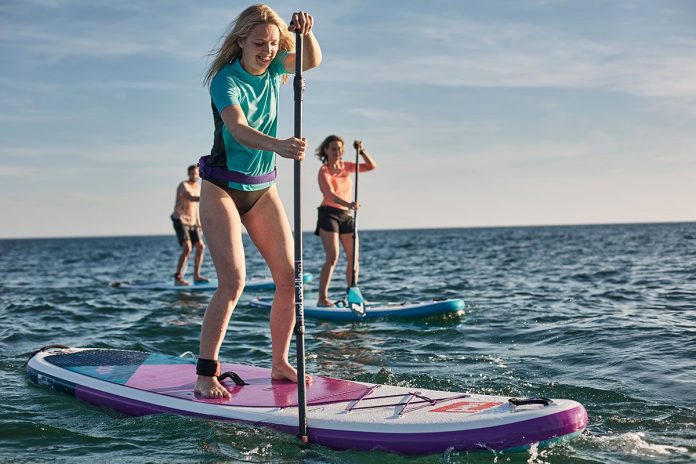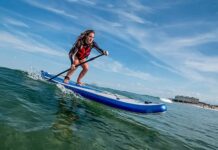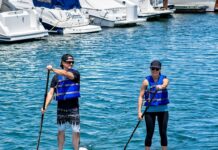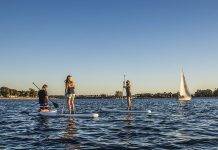When it comes to getting active on the water, choosing the right stand-up paddle (SUP) board can make all the difference.
Whether you’re looking to boost your fitness or enjoy a leisurely paddle, understanding the critical differences between a board designed for fitness and one for recreational use is crucial.
In this article, we’ll explore the essential factors that make a SUP board ideal for fitness activities and how it differs from a board designed for recreational paddleboarding. So, whether you’re a fitness enthusiast or simply looking to unwind on the water, we’ve got you covered.
Differences between Fitness and Recreational Paddleboarding
When choosing a paddleboard, there are several factors to consider depending on whether you are looking for a board that suits your fitness goals or for recreational purposes. Here, we will explore the main differences between fitness and recreational paddleboarding to help you make an informed decision.
Stability
Stability is crucial regardless of whether you use your paddleboard for fitness or recreational purposes. However, fitness paddleboards usually prioritize stability over other features due to the need for balance during workout sessions.
For fitness paddleboarding, wider boards are generally preferred as they offer a greater surface area for stability. This helps in maintaining balance and performing various exercises comfortably on the board. Additionally, a flatter rocker profile, which refers to the curvature of the board’s bottom, provides added stability by allowing the board to sit higher on the water.
Speed and Efficiency
While speed and efficiency may not be the primary focus for recreational paddleboarding, they become more crucial for fitness enthusiasts who want to maximize their workout sessions. Narrower boards are typically favored for fitness paddleboarding as they cut through the water with minimal resistance, allowing you to paddle faster and more efficiently.
Fin configurations also play a role in achieving better speed and efficiency. Fitness paddleboards often feature a single or multiple smaller fins, known as a tri-fin setup, which reduces drag and improves maneuverability.
The hull shape and length can also impact speed and efficiency. Fitness paddleboards may have displacement hulls designed to slice through the water with minimal effort, making them more efficient for long-distance paddling.
Maneuverability
Maneuverability is of greater importance for recreational paddleboarding, as it allows users to navigate various water conditions and obstacles easily. Shorter boards are typically more maneuverable, making them ideal for recreational use, where agility and control are essential.
The tail shape also plays a significant role in maneuverability. Recreational paddleboards often have a round or square tail shape, which provides more stability and maneuverability in calm waters.
Tracking
Tracking refers to the ability of a paddleboard to maintain a straight course. While necessary for fitness and recreational paddleboarding, it is crucial for longer-distance paddling and maintaining speed.
Fitness paddleboards prioritize tracking by incorporating longer boards and fin configurations that enhance stability and keep the board on a straight track. Additionally, a sharp rail shape, the board’s edge, can improve tracking by reducing drag in the water.
Weight Capacity
Weight capacity is an essential consideration for both fitness and recreational paddleboarding. Fitness paddleboards are often designed to accommodate additional weight due to the possibility of carrying extra equipment or performing exercises on the board.
The LA fitness paddleboard’s Larger volume and width help increase its weight capacity. Additionally, materials used in construction, such as higher-density foams or reinforcements, can contribute to a higher weight capacity.
Design
Design plays a significant role in determining the performance and functionality of a paddleboard. For fitness paddleboarding, the design can vary depending on the specific activity or workout routine you plan to engage in.
Different hull types, such as displacement or planing hulls, cater to different needs. Displacement hulls are more suitable for long-distance paddling and speed while planing hulls are better for maneuverability and stability in various water conditions.
Specialized fitness paddleboards are also designed for activities such as fishing or yoga. These boards often have unique features like additional attachment points for accessories or a more expansive deck for stability during yoga poses.
Another design consideration is the choice between solid and inflatable SUP boards. Solid boards provide better performance and stability, while inflatable boards offer portability and convenience for those who travel frequently.
Board Size
Choosing the right board size is essential for both fitness and recreational paddleboarding. Determining the appropriate board size depends on factors such as your weight, skill level, and intended use.
Larger boards are generally favored for fitness paddleboarding as they offer more stability and space for exercise. However, it is essential to balance size and maneuverability to ensure a comfortable and enjoyable experience on the water.
Recreational paddleboards come in various sizes, with smaller boards offering increased maneuverability and larger boards providing more stability. When selecting the appropriate size, it is essential to consider your skill level and the water conditions you will be paddling in.
Deck Pad and Traction
The deck pad and traction on a paddleboard contribute to the overall comfort and grip while out on the water. This is important for fitness and recreational paddleboarding to ensure a secure footing and prevent slips.
Fitness paddleboards often feature a full-length deck pad, providing ample grip and comfort for various exercises and movements. A full-length deck pad allows users to move freely without worrying about slipping or losing balance.
Recreational paddleboards may have a limited or smaller deck pad, as maneuverability and ease of movement are prioritized. However, it is still essential to have adequate traction at key contact points on the board to ensure a safe and enjoyable experience.
Attachment Points and Storage
Attachment points and storage options can significantly enhance the functionality of a paddleboard. Fitness paddleboards often offer more attachment points to secure equipment, such as resistance bands or a water bottle holder, enabling users to engage in various workouts and activities.
Recreational paddleboards may have fewer attachment points, but they often provide storage options such as bungee cord systems or tie-down points to secure personal belongings or equipment for a day of fun on the water.
Durability
Durability is an essential factor to consider when choosing a paddleboard, as it affects the lifespan and overall performance of the board. Both fitness and recreational paddleboards should be built to withstand the rigors of regular use and varying water conditions.
The construction material and reinforcements used in the board’s design can significantly impact its durability. Fitness paddleboards may incorporate higher-density foams or added reinforcements to ensure they can withstand workouts’ additional weight and impact.
Although convenient in terms of portability and storage, inflatable paddleboards may require more attention when it comes to durability. Proper care, maintenance, and repair techniques are necessary to prolong the lifespan of an inflatable SUP board.
In conclusion, while there are similarities between fitness and recreational paddleboarding, there are also key differences that should be considered when selecting a paddleboard for your specific needs.
By understanding the variations in stability, speed and efficiency, maneuverability, tracking, weight capacity, design, board size, deck pad and traction, attachment points and storage, and durability, you can make an informed decision that will optimize your paddleboarding experience, whether it be for fitness goals or recreational enjoyment.





































